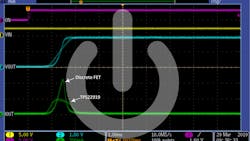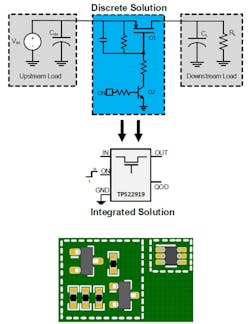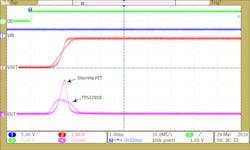Download this article in PDF format.
Power is an important aspect of any design, but distributing it safely and efficiently throughout your circuit boards and subassemblies can be challenging. To distribute voltage to the power-supply rails, you can employ discrete MOSFETs and a handful of passive components.
An alternative is to employ an integrated power device that not only distributes voltage, but also can offer additional features such as inrush current control, adjustable current limit, short-circuit protection, reverse-polarity protection, overvoltage protection, thermal shutdown, and current monitoring—all while keeping BOM count and circuit-board real estate to a minimum.
Sponsored Resources:
- 11 ways to protect your power path
- The basics of eFuses
- When to make the switch to an integrated load switch
An Introduction to Integrated Load Switches
An example of an integrated load switch is Texas Instruments’ TPS22919. As illustrated in Figure 1, compared with a discrete power-switch implementation, the TPS22919 can cut your bill-of-materials (BOM) count from six to one and reduce the required board real estate from 17.08 mm2 to 4.1 mm2.
1. Compared with a discrete solution (top), the TPS22919 integrated power switch (middle) can cut your BOM count from six to one and reduce the required board real estate from 17.08 mm2 (bottom left) to 4.1 mm2 (bottom right).
In addition, an integrated power switch can offer features not readily achievable with discrete components. For example, with the discrete implementation in Figure 1, the capacitor connected from the source to gate of the PMOS FET (Q1) helps limit the startup-voltage rise time. However, the nonlinear RC response makes it difficult to control inrush current, which exceeds 400 mA for the example shown in Figure 2. In contrast, the TPS22919 offers a linear soft-start capability that limits inrush current to 200 mA (Fig. 2, again).
2. In circuit examples involving a 100-μF load and similar rise times, a discrete implementation results in inrush current exceeding 400 mA, while the integrated power switch limits inrush to 200 mA.
Another feature of an integrated power switch is thermal shutdown, a function that a discrete FET can’t perform if its junction-temperature limit is exceeded, potentially leading to downstream damage as well as damage to the FET itself.
Also available with an integrated switch is quick output discharge (QOD), which discharges VOUT through an internal path to ground when the switch is disabled. This prevents the output from floating or entering an undetermined state when power is turned off. Adding this feature in a discrete solution would require an external FET. Integrated power switches can also save power by disconnecting power from inactive loads.
Power Multiplexer and eFuse Devices
Other integrated switches that can help protect your power path include power multiplexer devices and eFuses. The former allows a system to transition seamlessly between different power sources: a line-driven power supply and a battery, for example. Power multiplexers can switch between different power rails in three general ways: manually, by toggling a device’s enable pin; automatically, upon detection of failure or disconnection of a primary power supply; or a combination of approaches, in which a default automatic switchover mode can be overridden by an external microcontroller.
Similar to load switches, power multiplexer switches also feature inrush current control. On top of that, they offer adjustable current limits and a thermal-shutdown function, which in response to an overtemperature condition will turn off the switch until it can again operate safely.
An eFuse is an integrated active circuit-protection device that limits currents and voltages to safe levels during fault conditions. It offers advantages compared with solutions involving fuses or positive-temperature-coefficient (PTC) resistors, which present significant drawbacks. Fuses and PTC resistors react to temperature, and it can be difficult to predict the current levels to which they will respond.
In addition, a fuse after opening must be physically replaced, increasing downtime and maintenance costs. Furthermore, fuses and PTC resistors are comparatively slow to respond (milliseconds for PTC resistors and milliseconds to seconds for fuses) and don’t offer functions such as inrush-current control or overvoltage protection. Active discrete circuit-protection solutions may offer these features, but they can be bulky and inefficient.
An eFuse embeds various functions to limit inrush current while protecting a system against overcurrent, overvoltage, reverse-current, and reverse-polarity conditions as well as short-circuit faults. The eFuse is fast and accurate and can “repair” itself without user intervention. An eFuse requires few external components (a resistor to set the current-limit level and a capacitor to set the output-voltage ramp rate), resulting in board real-estate savings compared with discrete solutions.
From Hot-Swap Controller to Low-Side Switch
In addition to the load switch, power multiplexer, and eFuse, power devices are available in topologies including the hot-swap controller, ideal-diode controller, smart high-side switch, and low-side switch.
Unlike eFuses, hot-swap controllers drive an external MOSFET that can protect a system against hot-plug events that could adversely affect upstream voltages. The external MOSFET allows hot-swap controllers to operate at higher voltage and current levels than do eFuses. When a device (such as a disk drive) that includes the hot-swap controller is inserted into a live power system, the controller measures the inrush current across a sense resistor and, if necessary, reduces the MOSFET gate voltage to keep inrush currents at an acceptable level.
Similar to a hot-swap controller, an ideal-diode controller employs an external FET and, just like a regular diode, can block reverse current whenever a reverse-voltage event occurs. The controller can also protect against ground shorts at the input.
In addition, ideal-diode controllers can protect against reverse-polarity conditions, commonly caused by connecting a battery incorrectly or mis-wiring a power supply. Ideal diodes can act as ORing controllers, too, providing power redundancy when two or more power supplies are connected to a single load.
Smart high-side switches are designed to drive off-board loads. They support adjustable current limits that enable a system to be optimally designed for specific loads. An external resistor sets the current-limit threshold, allowing the switch to protect the load and power supply from overstressing during short-circuits to GND events or power-up conditions.
These switches also provide current sensing to support real-time system diagnostics. In automotive applications, smart high-side switches offer load-dump compatibility, which allows them to connect directly to a 12-V battery without concerns about typical voltage and current transients.
Finally, low-side switches connect and disconnect a load from ground, unlike the other power-switch topologies that connect and disconnect a load from VCC. Allowing low-side switches to drive inductive loads, this configuration incorporates an internal flyback diode that prevents inductive transients from damaging the circuit and components when the switch opens. Whenever the switch is opened, inductive transient currents flow through the flyback diode and dissipate throughout the load, making low-side switches suitable for applications involving motors, solenoids, and relays.
Sponsored Resources:


